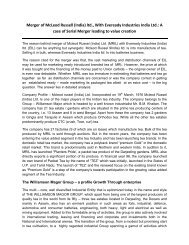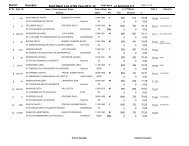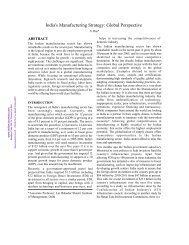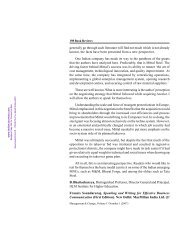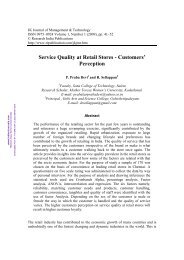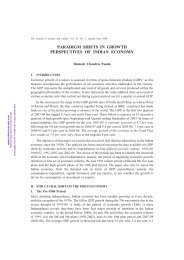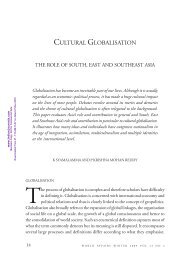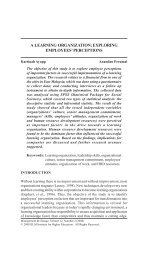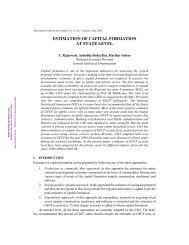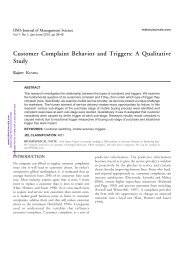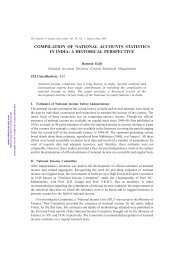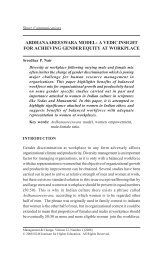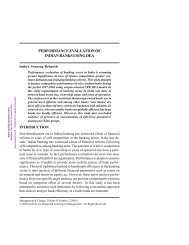unit 1 meaning, nature, scope and significance of human ... - Mimts.org
unit 1 meaning, nature, scope and significance of human ... - Mimts.org
unit 1 meaning, nature, scope and significance of human ... - Mimts.org
Create successful ePaper yourself
Turn your PDF publications into a flip-book with our unique Google optimized e-Paper software.
UNIT 1 MEANING, NATURE, SCOPE AND<br />
SIGNIFICANCE OF HUMAN RESOURCE<br />
MANAGEMENT<br />
Structure<br />
1.0 Learning Outcome<br />
1.1 Introduction<br />
1.2 Underst<strong>and</strong>ing HRM<br />
1.3 Role <strong>of</strong> the HR Manager<br />
1.4 Future Challenges to HRM<br />
1.5 Conclusion<br />
1.6 Key Concepts<br />
1.7 References <strong>and</strong> Further Reading<br />
1.8 Activities<br />
1.0 LEARNING OUTCOME<br />
After studying this Unit, you should be able to:<br />
• Discuss <strong>human</strong> resource management particularly highlighting its<br />
<strong>significance</strong> to public <strong>and</strong> private management;<br />
• Bring out its implications; <strong>and</strong><br />
• Distinguish related concepts like <strong>human</strong> resource development, personnel<br />
management <strong>and</strong> industrial relations.<br />
1.1 INTRODUCTION<br />
Organisations in their functional aspect are treated comprehensively under the<br />
wide, architectonic rubric / discipline <strong>of</strong> Human Resource Management. Simply<br />
put, <strong>human</strong> resource management is a ‘management function’ that focuses on the<br />
‘people’ dimension to/ <strong>of</strong> <strong>org</strong>anisations.<br />
As <strong>org</strong>anisations get larger <strong>and</strong> sophisticated <strong>and</strong> processes more complex, it gets<br />
increasingly difficult to coordinate specialisations at various policy <strong>and</strong> operating<br />
levels. The HR department performs the vital task <strong>of</strong> weaving sectional <strong>and</strong><br />
individual interests <strong>and</strong> practices into the matrix <strong>of</strong> group functioning, that is the<br />
‘<strong>org</strong>anisation’. Organisations had hitherto looked at the "Personnel Department,"<br />
for management <strong>of</strong> paperwork involving hiring <strong>and</strong> paying people. More recently,<br />
<strong>org</strong>anisations consider the <strong>human</strong> resource department better suited for the task.<br />
HRM plays a significant part in both regulatory <strong>and</strong> policy planning functions.<br />
Though in-charge, theoretically, <strong>of</strong> the traditional POSDCORB functions, HRM<br />
today ventures beyond theoretical postulates. The coverage <strong>of</strong> HRM has<br />
exp<strong>and</strong>ed to more enveloping domains in the discipline <strong>and</strong> pr<strong>of</strong>ession, throwing<br />
open possibilities in the art, science <strong>and</strong> craft <strong>of</strong> management theory <strong>and</strong> practice<br />
respectively.<br />
1
HRM covers myriad functions such as the specific <strong>and</strong> defined areas <strong>of</strong> planning<br />
<strong>and</strong> control, resource allocation, conflict resolution <strong>and</strong> settlement <strong>of</strong> legal claims,<br />
to recount a few. HRM function has evolved so much so that the HRM tag could<br />
eve be held misleading (Mahoney, 1994), as HRM is not limited anymore to<br />
securing 'person power'. Human resource management entails advising,<br />
implementing <strong>and</strong> <strong>org</strong>anising change, which are identified as the three important<br />
requisites <strong>of</strong> sound HRM practice.<br />
HRM is at the forefront <strong>of</strong> management strategy in the contemporary times. It is<br />
expected to be proactive rather than a reactive management function. It plays a<br />
vanguard role <strong>and</strong> imparts direction to an <strong>org</strong>anisation. The personnel department<br />
does not merely "h<strong>and</strong> out gift certificates for thanksgiving turkeys" (Mazarres,<br />
1994). It’s a pervasive management function actively involved in managing <strong>and</strong><br />
administering <strong>org</strong>anisation wide processes, initiating policy with regard to HR<br />
specifically, <strong>and</strong> also other sections, collaterally involving the <strong>human</strong> resource<br />
management function. It is more than a cosmetic or a fringe activity or function.<br />
HR management today involves more than just the management <strong>of</strong> the HR<br />
function. It extends into areas such as compensation benefits, staffing, HR<br />
forecasting, succession planning, management <strong>and</strong> executive development,<br />
performance management, employee relations, <strong>org</strong>anisation development, total<br />
quality management, needs analysis, instructional design <strong>and</strong> development<br />
training programme evaluation, return on investment (ROI), impact studies to<br />
name a few”(Mazarrese, 1994).<br />
Human resource management is therefore understood as the all significant art <strong>and</strong><br />
science <strong>of</strong> managing people in an <strong>org</strong>anisation. It’s <strong>significance</strong> lies in the fact<br />
that physical <strong>and</strong> monetary resources cannot <strong>and</strong> do not sustain increased rates <strong>of</strong><br />
return on investments, unless complemented <strong>and</strong> supplemented effectively by<br />
good <strong>human</strong> resource practices which reflect in best st<strong>and</strong>ards <strong>of</strong> productivity <strong>and</strong><br />
service delivery. Increasing research output in behavioral sciences, new trends in<br />
managing ‘knowledge workers’ <strong>and</strong> advances in training methodology <strong>and</strong><br />
practices have led to substantial expansion <strong>of</strong> the <strong>scope</strong> <strong>of</strong> <strong>human</strong> resource<br />
management function in recent years, besides adding to its underst<strong>and</strong>ing as a<br />
theoretical area <strong>of</strong> enquiry.<br />
Use <strong>of</strong> the word ‘management’ is significant here. It is new public management<br />
informing management ethic today. Consequently, ‘administration’ is used to<br />
denote more routine coordination functions while ‘management’ is perceived as<br />
the active or the potent functional aspect <strong>of</strong> an enterprise; more pertinently, the art<br />
<strong>and</strong> science <strong>of</strong> “getting things done” (Simon, 1957). Significantly, management<br />
function is universal in public <strong>and</strong> private <strong>org</strong>anisations (Fayol, 1959).<br />
HRM is not just an arena <strong>of</strong> personnel administration anymore but rather a central<br />
<strong>and</strong> pervasive general management function involving specialised staff as<br />
assistants to main line managers.<br />
2
Evolution <strong>of</strong> HRM<br />
Historically, the beginning <strong>of</strong> HRM is traced to Robert Owen <strong>and</strong> his large<br />
spinning mills in Scotl<strong>and</strong>. Charles Babbage <strong>and</strong> Henry Towde are the other two<br />
names associated with HRM’s early beginnings. Its growth was particularly<br />
marked in the inter-war era which was also the heyday <strong>of</strong> the <strong>human</strong> relations <strong>and</strong><br />
its subsequent branching into the diagnostic, behavioural movement. The latter<br />
being more applied <strong>and</strong> scientific in <strong>nature</strong>, has since then developed along highly<br />
specialised lines. It has branched out specifically along the domains <strong>of</strong> applied<br />
psychology <strong>and</strong> sociology. The latter in turn has evolved around the concept <strong>of</strong><br />
the ‘welfare state’ while the former has proceeded as the behavioural science<br />
movement. The art <strong>and</strong> science <strong>of</strong> personnel management is inclusive <strong>and</strong><br />
incorporates the two trends. The diagram beneath illustrates the development or<br />
evolution <strong>of</strong> personnel management through recorded time (the figure is selfillustrative).<br />
The theory <strong>and</strong> practice <strong>of</strong> <strong>human</strong> resource management is based primarily in<br />
sociology <strong>and</strong> economics. For Keeney (1990), <strong>human</strong> resource management is the<br />
conceptual euphemism to describe all the apparently transformative changes in<br />
the management <strong>of</strong> employee relations in the 1980s. Blunt (1990) suggests that<br />
in the late 1970s <strong>and</strong> even into the early 1980s, the discipline concerned with the<br />
<strong>human</strong> side <strong>of</strong> the enterprise was largely regarded as covering moribund<br />
housekeeping operational activities. Consequently, there was no status <strong>and</strong><br />
influence <strong>of</strong> the discipline. Guest (1990) attributes the concern with status to the<br />
origins <strong>of</strong> personnel management “as an extension <strong>of</strong> scientific management or a<br />
form <strong>of</strong> welfare management. Hegg (1995) points it out as the contrast between<br />
the high aspirations <strong>of</strong> the normative model <strong>and</strong> <strong>of</strong> the failure to deliver as<br />
reflected in the behaviourist model.” It later developed in stages through<br />
consistent research in the area so much so that at present; it is a pioneering area in<br />
management. New dimensions continue to be added to it, lending it a unique<br />
3
dynamic character. It now covers diverse areas, as, mutual underst<strong>and</strong>ing at the<br />
work place between employers <strong>and</strong> employees <strong>and</strong> the socio technical school <strong>of</strong><br />
thought emphasising restructuring <strong>of</strong> work to match social <strong>and</strong> technical systems<br />
(Schein 1988). Organisation Development (OD), Human Resources Accounting<br />
(HRA) <strong>and</strong> Quality <strong>of</strong> work life (QWL) are the most recent precursors <strong>of</strong> HRM.<br />
HRA was popularised by Flamholitz (1985) which represented the ultimate quest<br />
for legitimacy through quantification. HRM’s financial implications are studied<br />
under ‘<strong>org</strong>anisational imperatives’ (Kamoche, 1994).<br />
1.2 UNDERSTANDING HRM<br />
We may now attempt to elucidate the subject under study. Before attempting the<br />
same, let us explain the essentials that require finding place in any definition. The<br />
core issues are pointed out as:<br />
- Human resource strategies are derived from the overall business strategy<br />
in the same way as investment or marketing strategies. Decisions relating<br />
to employees need to be integrated <strong>and</strong> made consistent with other<br />
decisions.<br />
- Organisations are not mere structural entities but ‘social <strong>unit</strong>s’ comprising<br />
not just bricks, mortars, machineries or inventories, but, people. It has<br />
been observed by scholars that an <strong>org</strong>anisation is not a complex <strong>of</strong> matter<br />
but rather a complex <strong>of</strong> <strong>human</strong>ity. Personnel management deals with the<br />
effective control <strong>and</strong> use <strong>of</strong> manpower as distinguished from other sources<br />
<strong>of</strong> power.<br />
HRM differs from Personnel Management in treating people as ‘resource’.<br />
People are <strong>human</strong> capital <strong>and</strong> are treated as resource, in that tangible <strong>and</strong><br />
intangible benefits flow from their utilisation. Organisations have to<br />
effectively harness this resource in order to be productive.<br />
- An <strong>org</strong>anisation must make appropriate use <strong>of</strong> ‘<strong>human</strong> capital’ for<br />
achievement <strong>of</strong> both collective <strong>org</strong>anisational <strong>and</strong> individual goals,<br />
mutually as well as in t<strong>and</strong>em. Coincidence <strong>and</strong> compatibility <strong>of</strong> the two is<br />
specially stressed for the sake <strong>of</strong> ‘<strong>org</strong>anisational equilibrium’ in that the<br />
individual <strong>and</strong> the <strong>org</strong>anisation represent two ‘opposing poles’ <strong>of</strong><br />
<strong>org</strong>anisational effort. Though their interests come across as competing<br />
forces, they are not always mutually contradictory <strong>and</strong> can be reconciled in<br />
the interest <strong>of</strong> ‘<strong>org</strong>anisational purpose.’ The aim <strong>of</strong> <strong>human</strong> resource<br />
management is to balance the equation <strong>and</strong> bring about required synergy to<br />
reinforce mutuality <strong>of</strong> effort towards the ‘common purpose.’<br />
Organisational Equilibrium is achieved by matching ‘inducements’<br />
(positive balance’) to ‘contributions’ (negative balance on the part <strong>of</strong><br />
workers (Barnard, 1938).<br />
4
- The final ‘value’ or ‘end’ in this case is ‘<strong>org</strong>anisational effectiveness’<br />
understood as increasing ‘<strong>org</strong>anisational capacity’ in the face <strong>of</strong><br />
environmental dynamics with attendant impacts on <strong>org</strong>anisational <strong>and</strong><br />
‘structuring’ <strong>and</strong> ‘functioning’ (Simon, 1957). There is an unmistakable<br />
reference here to the ‘contingency paradigm’ <strong>of</strong> administrative theory.<br />
Specific environmental variables could be identified as technology,<br />
available knowledge, physical <strong>and</strong> material resource, government policy,<br />
etc. Maintaining ‘relevance’ <strong>of</strong> <strong>org</strong>anisational functioning in the context <strong>of</strong><br />
shifting ecological variables is always a challenge <strong>and</strong> has to be addressed<br />
for the sake <strong>of</strong> ‘efficiency,’ understood as favourable cost- benefit ratio<br />
(Simon, 1957).Together the two make for ‘effectiveness’ <strong>of</strong> the<br />
<strong>org</strong>anisation.<br />
Defining HRM<br />
The following four definitions encompass the aforesaid core issues in <strong>human</strong><br />
resource management. HRM could thus be referred to as;<br />
1. …..a series <strong>of</strong> integrated decisions that govern employer-employee<br />
relations. Their quality contributes to the ability <strong>of</strong> <strong>org</strong>anisations <strong>and</strong><br />
employees to achieve their objectives (Milkovich & Boudreau, 1997).<br />
2. … Concerned with the people dimension to management. Since every<br />
<strong>org</strong>anisation comprises people, acquiring their services, developing their<br />
skills, motivating them to higher levels <strong>of</strong> performance <strong>and</strong> ensuring that<br />
they continue at the same level <strong>of</strong> commitment to the <strong>org</strong>anisation are<br />
essential to achieving <strong>org</strong>anisational goal. This is true, regardless <strong>of</strong> the<br />
type <strong>of</strong> <strong>org</strong>anisation: viz. government, business, education, health,<br />
recreation, or social action. (Decenzo & Robbins, 1989).<br />
3. … the planning, <strong>org</strong>anising directing <strong>and</strong> controlling <strong>of</strong> the procurement,<br />
development, compensation, integration, <strong>and</strong> maintenance <strong>of</strong> <strong>human</strong><br />
resource to the end those individual, <strong>org</strong>anisational, <strong>and</strong> social objectives are<br />
accomplished. (Flippo, 1984).<br />
4. “….. The <strong>org</strong>anisation function that focuses on the effective management,<br />
direction, <strong>and</strong> utilisation <strong>of</strong> people; both the people who manage produce<br />
<strong>and</strong> market <strong>and</strong> sell the products <strong>and</strong> services <strong>of</strong> an <strong>org</strong>anisation <strong>and</strong> those<br />
who support <strong>org</strong>anisational activities. It deals with the <strong>human</strong> element in<br />
the <strong>org</strong>anisation, people as individuals <strong>and</strong> groups, their recruitment,<br />
selection, assignment, motivation, empowerment, compensation,<br />
utilisation, services, training, development, promotion, termination <strong>and</strong><br />
retirement.”(Tracey,1994 )<br />
From the above definitions, certain new <strong>and</strong> some <strong>of</strong> the most important ones<br />
HRM aspects emerge could be stated as:<br />
1. There is an explicit link between managing <strong>human</strong> resource <strong>and</strong><br />
success <strong>of</strong> administrative or management strategy. Competition forces<br />
management to alter the latter with implications for the former.<br />
2. Sector strategies cannot be appreciated in isolation (mean in Simon’s<br />
terms) but only as parts <strong>of</strong> the integral whole.<br />
5
3. Senior line managers are required to assume more responsibility with<br />
regard to managing <strong>human</strong> resource. There is a stress on interpersonal<br />
relations as a determinant <strong>of</strong> performance.<br />
Versions <strong>of</strong> HRM<br />
Hard Version<br />
“Human resource management reflects a long-st<strong>and</strong>ing capitalist tradition in<br />
which workers are regarded as commodity.” (Guest: 1999). Hard approach to<br />
<strong>human</strong> resource management is a pragmatic perspective to <strong>human</strong> resource<br />
management which looks upon people as ‘resource’ <strong>and</strong> measures the tangible<br />
benefits accruing from their deployment. Human resources have to be acquired,<br />
developed <strong>and</strong> deployed in ways that maximise their utility. The focus is on<br />
calculative <strong>and</strong> strategic aspect <strong>of</strong> managing <strong>human</strong> resource <strong>and</strong> the approach is<br />
“rational” (fact- based) with regard to factors <strong>of</strong> production. The objective is<br />
‘efficiency’ (maximising benefit <strong>and</strong> minimising cost) <strong>and</strong> the philosophy is<br />
business-orientation (specifically <strong>human</strong> resource accounting) with emphasis on<br />
tangible <strong>and</strong> quantifiable value addition to the <strong>org</strong>anisation. It has been stated that<br />
the drive to adopt <strong>human</strong> resource management is based on the business need to<br />
respond to the external threat arising from increasing competition. It is a<br />
philosophy that appeals to management’s striving hard at achieving <strong>and</strong> sustaining<br />
competitive edge <strong>and</strong> appreciate that to do it they must invest in <strong>human</strong> resource<br />
as well as they do for other practices or for other areas (for example, procuring<br />
technology).<br />
The emphasis is on:<br />
• drive for economy <strong>and</strong> efficiency;<br />
• interest <strong>of</strong> management as opposed to workers;<br />
• adoption <strong>of</strong> a strategic approach that is in line with business strategy;<br />
• obtaining value-adding services from people through targeted <strong>human</strong><br />
resource development practices;<br />
• emphasis on strong people centric <strong>org</strong>anisational culture, expressed or<br />
articulated in the mission or value statement <strong>and</strong> reinforced by<br />
communications, training <strong>and</strong> performance management processes; <strong>and</strong> ;<br />
• the need to obtain agreed commitment <strong>of</strong> employees towards goals <strong>and</strong><br />
purpose (s) <strong>of</strong> the <strong>org</strong>anisation.<br />
S<strong>of</strong>t Version<br />
The ‘s<strong>of</strong>t’ model <strong>of</strong> <strong>human</strong> resource management traces its origin to the <strong>human</strong><br />
relations school <strong>of</strong> administrative thought <strong>and</strong> emphasises development <strong>of</strong> healthy<br />
<strong>org</strong>anisational culture by use <strong>of</strong> effective communication, motivation <strong>and</strong><br />
leadership as primary sources <strong>of</strong> maximising performance. It looks upon<br />
employees as ‘co-contributors’ rather than adjuncts in <strong>org</strong>anisational culture,<br />
‘objects’ or pieces <strong>of</strong> automation. It stresses on the need to gain sustained<br />
commitment <strong>of</strong> employees through democratic means such as participative<br />
6
management, <strong>meaning</strong>ful involvement in policy formulation <strong>and</strong> other methods <strong>of</strong><br />
developing ‘high-commitment-high-trust’ culture in the <strong>org</strong>anisation. Attention is<br />
therefore drawn to the key role <strong>of</strong> <strong>org</strong>anisational behaviour.<br />
Employees are treated as valued assets <strong>and</strong> a source <strong>of</strong> competitive advantage<br />
which needs to be optimised by evincing ethical virtues such as commitment,<br />
adaptability <strong>and</strong> high quality performance in consonance with the ‘collective will’<br />
<strong>of</strong> the <strong>org</strong>anisation articulated as <strong>org</strong>anisational purpose. Ethics lies in reciprocity<br />
between individual member <strong>and</strong> the management.<br />
The emphasis is on the belief that the interests <strong>of</strong> management <strong>and</strong> employees are<br />
congruent. This approach is also termed as the ‘<strong>unit</strong>ary’ approach’ to <strong>human</strong><br />
resource management.<br />
Reconciling the Two<br />
It has been observed that even if the rhetoric <strong>of</strong> <strong>human</strong> resource management is s<strong>of</strong>t the<br />
reality is <strong>of</strong>ten harsh, with the interests <strong>of</strong> the <strong>org</strong>anisation prevailing, more <strong>of</strong>ten than not,<br />
over that <strong>of</strong> the individuals’. Practically, we find a mix <strong>of</strong> hard <strong>and</strong> s<strong>of</strong>t versions informing<br />
<strong>org</strong>anisational practice. This implies that the distinction between hard <strong>and</strong> s<strong>of</strong>t HRM is not<br />
as specific or obvious as it is tacit <strong>and</strong> implied.<br />
Features <strong>of</strong> HRM<br />
By now we have been able to underst<strong>and</strong> the <strong>meaning</strong> <strong>of</strong> HRM. Some <strong>of</strong> the<br />
main features <strong>of</strong> HRM include (Keith sis son):<br />
1. There is stress on the integration <strong>of</strong> HR polices with overall planning <strong>and</strong><br />
underpinning latter with the former;<br />
2. Responsibility for personnel management no longer resides with specialist<br />
managers but is increasingly assumed by the senior line management;<br />
3. The focus consequently shifts from management-trade union relations to<br />
management-employee relations; from collectivizing to individuation;<br />
macro to micro; <strong>and</strong>;<br />
4. To reiterate, with the manager donning the role <strong>of</strong> “enabler”, or ‘facilitator’,<br />
there is stress on commitment <strong>and</strong> initiative on the part <strong>of</strong> the employees.<br />
HRM is based on the following four fundamental principles (Armstrong,<br />
1988:90).<br />
a. Human Resource is the <strong>org</strong>anisation’s most important asset;<br />
b. Personnel policies should be directed towards achievement <strong>of</strong><br />
corporate goals <strong>and</strong> strategic plans;<br />
c. Corporate culture exerts a major influence on achievement <strong>of</strong><br />
excellence <strong>and</strong> must therefore be tempered with consideration <strong>of</strong><br />
employee welfare.<br />
d. Whilst integration <strong>of</strong> corporate resources is an important aim <strong>of</strong><br />
HRM, it must also be recognised that all <strong>org</strong>anisations are<br />
‘pluralist societies’ in which people have differing interests <strong>and</strong><br />
7
concerns, which they defend <strong>and</strong> at the same time function<br />
collectively as a cohesive group.<br />
Besides the features mentioned earlier, certain more characteristics <strong>of</strong> HRM could<br />
be summarised as follows:<br />
1. HRM is a pervasive function. It permeates all levels <strong>of</strong> decision making in<br />
an <strong>org</strong>anisation. All sections perform <strong>human</strong> resource management in<br />
some way. Academically, the <strong>nature</strong> <strong>of</strong> the subject is inter-disciplinary. It<br />
draws inputs from other social sciences, particularly, sociology,<br />
psychology, political science, anthropology, economics, etc. HRM has a<br />
suggestion <strong>of</strong> the contingency paradigm here. Chief among contingent<br />
variables is pressure from the government articulated through policy<br />
interventions through directives or orders. The three main areas <strong>of</strong><br />
potential pressure are identified as: affirmative action in pursuance <strong>of</strong><br />
social justice objectives; concern for occupational safety <strong>and</strong> health in a<br />
welfare state; <strong>and</strong> pension regulation for well being <strong>of</strong> workers<br />
2. HRM is also a comprehensive function, in that it is concerned directly or<br />
indirectly with every decision that in any way relates, even collaterally to<br />
<strong>human</strong> resource management, irrespective <strong>of</strong> the section it emanates from<br />
or the level at which it is made.<br />
3. Cost effectiveness is a must to attract, induce <strong>and</strong> mobilise resources for its<br />
policies, draw the attention <strong>of</strong> main line management to its policies <strong>and</strong><br />
proposals.<br />
4. There is a need to spot trends <strong>and</strong> tailor personnel requirements<br />
accordingly towards perceived direction or end, to make optimum<br />
utilisation <strong>of</strong> available <strong>human</strong> capital.<br />
5. Human resource management department provides for an integrating<br />
mechanism. It attempts to build <strong>and</strong> maintain coordination between all<br />
operative levels in an <strong>org</strong>anisation. It is indispensable as a clearing house.<br />
Its added <strong>significance</strong> is due to its being an auxiliary service which is an<br />
indispensable maintenance activity. HR department aids ‘line’ <strong>of</strong>ficials<br />
perform their respective allotted tasks, with direct or incidental bearing on<br />
<strong>human</strong> resource. Policy- making does not proceed piecemeal <strong>and</strong><br />
<strong>org</strong>anisational functioning is imparted a coherence that might otherwise be<br />
hard to achieve. Human resource manager is therefore a specialist advisor<br />
<strong>and</strong> performs vital staff function.<br />
6. HRM is an imperative function for all complex <strong>org</strong>anisations where inter<br />
section interests are inextricably linked. It is action oriented as in it the<br />
focus is on action, rather than record keeping, written procedures or rules.<br />
The problems <strong>of</strong> employees at work are solved through rational, st<strong>and</strong>ard<br />
policies.<br />
7. HRM seeks to maximise employee motivation to make them contribute to<br />
their maximum potential. The same is done through a systematic process<br />
<strong>of</strong> recruitment, selection, training <strong>and</strong> development together with workerfriendly<br />
policies like fair wage, bonus <strong>and</strong> reward system, effective<br />
grievance redressal, etc.<br />
8
8. HRM is people oriented. Peoples’ existence is defined or perceived in two<br />
ways, that is, as individuals working for personal satisfaction <strong>and</strong> members<br />
<strong>of</strong> a group or collectivity, contributing towards a common objective.<br />
Together they constitute the pillars <strong>of</strong> <strong>org</strong>anisation or <strong>org</strong>anisation wide<br />
effort. ‘Organisational equilibrium’ is contingent on matching or balancing<br />
personal need satisfaction (inducements <strong>of</strong>fered) with <strong>org</strong>anisational goal<br />
fulfillment (contributions elicited/negative balance). Right man in the right<br />
place at the right time maximises benefit <strong>of</strong> collective endeavour both in<br />
the interest <strong>of</strong> the <strong>org</strong>anisation <strong>and</strong> the individual employee. HRM is<br />
development oriented; it aids institution <strong>of</strong> employee-friendly activities<br />
like career planning <strong>and</strong> development which help develop their full<br />
potential. Job enlargement <strong>and</strong> job rotation practices are facilitated;<br />
employees are assigned a variety <strong>of</strong> tasks, which helps them to gain<br />
maturity, experience <strong>and</strong> exposure.<br />
9. Tangible quantifiable benefits result to the <strong>org</strong>anisation as also<br />
externalities, intangibles or unquantifiable gains (improved <strong>org</strong>anisational<br />
culture, management-worker relations, etc.) which optimise <strong>org</strong>anisational<br />
performance. Enhanced productivity is then used to reward employees<br />
monetarily <strong>and</strong> motivate them further towards better <strong>and</strong> improved<br />
performance.<br />
10. HRM is continuous activity, consistent function <strong>and</strong> not a short-term<br />
measure. It requires constant alertness <strong>and</strong> awareness <strong>of</strong> <strong>human</strong> relations<br />
on the part <strong>of</strong> managers to maintain healthy <strong>org</strong>anisational climate.<br />
Sustenance <strong>of</strong> ‘<strong>org</strong>anisational ‘rationality’ (with respect to decision<br />
making) <strong>and</strong> securing ‘<strong>org</strong>anisational effectiveness’ are other pressing<br />
concerns. Organisational survival is the prime concern. Concerns <strong>of</strong><br />
efficiency arise only later. Organisations face the challenge or imperative<br />
<strong>of</strong> arriving at an L.C.M. (least common denominator) <strong>of</strong> opposing pulls or<br />
conflicting interests within as well outside to ensure <strong>and</strong> secure compliance<br />
with exogenous directives <strong>and</strong> compatibility between internal (in-house)<br />
<strong>and</strong> external (laws, guidelines, implementation regulations) policies.<br />
External pressures need to be adapted to or co-opted for the sake <strong>of</strong><br />
‘relevance’ <strong>and</strong> ‘efficiency’ (Simon, 1957) <strong>of</strong> <strong>org</strong>anisational functioning.<br />
11. Human resource management function is <strong>of</strong> importance to Public as well<br />
as private <strong>org</strong>anisations. Fayol’s advocacy <strong>of</strong> management as a universal<br />
science endorses this idea.<br />
Objectives <strong>of</strong> HRM<br />
The primary objective <strong>of</strong> <strong>human</strong> resource management is to ensure a continuous<br />
flow <strong>of</strong> competent workforce to an <strong>org</strong>anisation. But this is only a broad view.<br />
Exploring further, we can categorise objectives into four, which are analysed as<br />
follows for a better underst<strong>and</strong>ing:<br />
Societal Objectives<br />
The society may constrain rationality with regard to <strong>human</strong> resource decisions<br />
through laws for example, reservation <strong>and</strong> other laws that address social<br />
9
discrimination, health <strong>and</strong> safety <strong>of</strong> workers, morale, ideological bias <strong>and</strong> other<br />
such issues <strong>of</strong> societal concern.<br />
Organisational Objectives<br />
The <strong>org</strong>anisational objective is at the forefront <strong>of</strong> <strong>org</strong>anisational strategy,<br />
coordinating <strong>and</strong> harmonising <strong>org</strong>anisation wide efforts <strong>and</strong> stressing on the role<br />
<strong>of</strong> <strong>human</strong> resource management in contributing towards <strong>org</strong>anisational<br />
effectiveness.<br />
Human resource management is not an end in itself. It is a means to the end <strong>of</strong><br />
increasing <strong>org</strong>anisational capability. It assists the <strong>org</strong>anisation in attaining its<br />
primary objectives. Simply stated, the department serves the rest <strong>of</strong> the<br />
<strong>org</strong>anisation.<br />
Functional Objectives<br />
On the functional side it sets the department’s contribution at the level most apt<br />
suited in the <strong>org</strong>anisational setting.<br />
Resources are wasted when <strong>human</strong> resource is either in excess or too scarce. The<br />
department function is to gain ‘<strong>org</strong>anisational fit’ with respect to <strong>human</strong> resource<br />
requirements.<br />
Empowerment is a core concept <strong>of</strong> the new management model. In an adaptive<br />
<strong>org</strong>anisation, empowerment is preferred to delegation; ownership to responsibility.<br />
It is contended that authority <strong>and</strong> responsibility are formal aspects <strong>of</strong> <strong>org</strong>anising.<br />
They are based on <strong>org</strong>anisational properties <strong>and</strong> not individual capabilities.<br />
Empowerment <strong>and</strong> ownership are social aspects <strong>of</strong> <strong>org</strong>anising. They are based on<br />
efficacy <strong>and</strong> initiative, <strong>and</strong> not just on roles <strong>and</strong> requirements. (Business E. Coach,<br />
2005)<br />
Clear articulation <strong>of</strong> policy following wider philosophy is imminent for success <strong>of</strong><br />
any <strong>org</strong>anisational <strong>and</strong> that success <strong>of</strong> the free market. Philosophy binds an<br />
<strong>org</strong>anisation internally, provides a focus to collective effort <strong>and</strong> helps competitors<br />
anticipate future moves <strong>of</strong> a company. According to theorists, two main concerns<br />
regarding competitive philosophy are (a) people- centered philosophy, <strong>and</strong> (b)<br />
<strong>unit</strong>y <strong>and</strong> focus.<br />
Sound <strong>human</strong> resource management determines the level <strong>of</strong> innovation or<br />
creativity in <strong>org</strong>anisational processes. Organisational capability is a dynamic<br />
concept. To what extent it is promoted depends on the premium attached to the<br />
HR function by the management. Bob Garratt (1990) proposes a theory <strong>of</strong><br />
<strong>org</strong>anisations as "learning systems" in which success depends on the ability <strong>of</strong><br />
managers to become "direction-givers" <strong>and</strong> on the <strong>org</strong>anisation's capacity for<br />
learning continuously.<br />
10
Personal Objectives<br />
It implies assistance rendered to employees in achieving their personal goals in so<br />
far as these goals enhance individuals’ contribution to the <strong>org</strong>anisation.<br />
Personal objectives <strong>of</strong> employees must be met if workers are to be retained <strong>and</strong><br />
motivated towards better performance. If otherwise be the case, employee<br />
performance <strong>and</strong> satisfaction are likely to decline <strong>and</strong> employees could even<br />
contemplate leaving the <strong>org</strong>anisation. Managing approach to employee benefits<br />
<strong>and</strong> compensation, employee records <strong>and</strong> personnel policies is an important aspect<br />
<strong>of</strong> <strong>human</strong> resource management (McNamara, 2005)<br />
There has to be a correlation between objectives <strong>and</strong> functions. William Werther<br />
Jr. <strong>and</strong> Keith Davis (1972) have attempted to link the two. This is summarised in<br />
the following table:<br />
HRM Objectives<br />
Societal Objectives<br />
Organisational Objectives<br />
Functional Objectives<br />
Personal Objectives<br />
Supporting Functions<br />
1. Legal compliance<br />
2. Benefits<br />
3. Union-management relations<br />
1. Human resource planning<br />
2. Employee relations<br />
3. Selection<br />
4. Training <strong>and</strong> development<br />
5. Appraisal<br />
6. Placement<br />
7. Assessment<br />
1. Appraisal<br />
2. Placement<br />
3. Assessment<br />
1. Training <strong>and</strong> development<br />
2. Appraisal<br />
3. Placement<br />
4. Compensation<br />
5. Assessment<br />
Like other issues in public administration, objectives <strong>of</strong> <strong>human</strong> resource<br />
management attract divergent views. In fact, due to changing environment <strong>and</strong><br />
11
dynamics <strong>of</strong> relationship among management, employees <strong>and</strong> trade unions,<br />
<strong>human</strong> resource management objectives have had new vistas added to its<br />
defining purpose. V.S.P. Rao (2000) recognises some <strong>of</strong> these changes <strong>and</strong><br />
places forth a set <strong>of</strong> emerging objectives:<br />
1. Research <strong>and</strong> development is a new facet to <strong>human</strong> resource<br />
management. HR practices need constant updating in view <strong>of</strong> changing<br />
legal, political, <strong>and</strong> social environment. Forethought <strong>and</strong> fore<br />
planning are vital to keep strategy targeted;<br />
2. The primary purpose <strong>of</strong> HRM is to realise people’s strengths, turn<br />
them into productive assets <strong>and</strong> benefit customers, stockholders <strong>and</strong><br />
employees at the same time, in an equally effectively manner;<br />
3. HRM requires that employees be motivated to make them exert their<br />
maximum efforts, that their performance be evaluated/ preferably<br />
measured properly <strong>and</strong> that they be remunerated on the basis <strong>of</strong> their<br />
contributions to the <strong>org</strong>anisation;<br />
4. HRM helps employees grow to their fullest potential, with reference to<br />
job satisfaction <strong>and</strong> self-actualisation. To this end, suitable<br />
programmes have to be designed aiming at improving the quality <strong>of</strong><br />
work life (QWL);<br />
5. To develop <strong>and</strong> maintain quality <strong>of</strong> work life, good working conditions<br />
<strong>and</strong> good st<strong>and</strong>ard <strong>of</strong> life for the worker makes employment in the<br />
<strong>org</strong>anisation a desirable personal <strong>and</strong> social condition. Without<br />
improvement in the quality <strong>of</strong> work life, it might be difficult to elicit<br />
desired level <strong>of</strong> motivation;<br />
6. It is the responsibility <strong>of</strong> HRM to establish <strong>and</strong> maintain<br />
communication well, to tap ideas, opinions <strong>and</strong> feelings <strong>of</strong> customers,<br />
non-customers, regulators <strong>and</strong> other external public as well as in<br />
underst<strong>and</strong>ing the views <strong>of</strong> internal <strong>human</strong> resources; <strong>and</strong><br />
7. HR function helps maintain ethical policies <strong>and</strong> behaviour in the<br />
<strong>org</strong>anisation. The chief personnel <strong>of</strong>ficer <strong>of</strong> a large American<br />
corporation puts it thus: “personnel’s purpose is to practice morality in<br />
management by preparing people for change, dealing with dissent <strong>and</strong><br />
conflict, holding high st<strong>and</strong>ards <strong>of</strong> productivity, building acceptance <strong>of</strong><br />
st<strong>and</strong>ards that determine progression <strong>and</strong> adhering to the spirit <strong>and</strong><br />
letter <strong>of</strong> high pr<strong>of</strong>essional conduct”.<br />
Scope <strong>of</strong> HRM<br />
The Indian Institute <strong>of</strong> Personnel Management encapsulates the <strong>scope</strong> <strong>of</strong> HRM in<br />
the following three aspects: -<br />
1. Personnel aspect: concerned with manpower planning, recruitment,<br />
selection, placement, transfer, promotion, training <strong>and</strong> development, lay <strong>of</strong>f<br />
<strong>and</strong> retrenchment, remuneration, incentives, productivity, etc.;<br />
12
2. Welfare aspect; dealing with working conditions <strong>and</strong> provision <strong>of</strong> amenities<br />
such as canteens, crèches, rest <strong>and</strong> lunch rooms, housing, transport, medical<br />
assistance, education, health, safety, recreation facilities, etc.; <strong>and</strong><br />
3. Industrial Relations aspect: the legal part which covers union-management<br />
relations, joint consultation, collective bargaining, grievance redress <strong>and</strong><br />
disciplinary procedures, settlement <strong>of</strong> disputes, etc.<br />
HR function may be categorised into the following sub- sections:<br />
• Employee Hiring<br />
• Employee <strong>and</strong> Executive Remuneration<br />
• Employee Motivation<br />
• Employee Maintenance<br />
• Industrial Relations<br />
• Prospects <strong>of</strong> Human Resource Management<br />
Carter McNamara (2005) has outlined the following activities <strong>of</strong> the HR section:<br />
-deciding what staffing needs an <strong>org</strong>anisation has, <strong>and</strong>, whether it should use<br />
independent contractors or hire its own employees. Cost considerations matter in<br />
these decisions. Also, in-house promotions <strong>and</strong> placements are encouraged as part<br />
<strong>of</strong> <strong>org</strong>anisational policy. Present environment dem<strong>and</strong>s more flexibility in policy<br />
formulation <strong>and</strong> implementation processes for which the HR department is most<br />
suited; <strong>and</strong>;<br />
- recruiting <strong>and</strong> training the best employees, ensuring they are high<br />
performers through apprenticeship <strong>and</strong> training programmes dealing with<br />
performance issues <strong>and</strong> ensuring personnel <strong>and</strong> management practices<br />
conform to all formal regulations, managing approach to employee benefit<br />
<strong>and</strong> motivation <strong>and</strong> group morale.<br />
Functions <strong>of</strong> the personnel section encompass the following activity areas:<br />
(Tracey, 1994)<br />
- Total quality management (TQM) applying system’s model or perspective<br />
to <strong>org</strong>anisation theory. For enhancing overall productivity, output levels<br />
<strong>and</strong> st<strong>and</strong>ards. Investing more time in value- adding activities as opposed<br />
to non- value adding is emphasised;<br />
- Organisational structuring <strong>and</strong> design; suggesting mergers, overseeing<br />
diversification/ expansion schemes, managing implications <strong>of</strong><br />
globalisation, cost cutting measures such as downsizing, contract<br />
employment, restructuring, controlling implications there<strong>of</strong>, etc.;<br />
- Productivity control, R&D, improved service delivery, customer focus,<br />
quality control, <strong>org</strong>anisational effectiveness;<br />
- Financial control <strong>and</strong> budgeting;<br />
-- Human Resource Planning <strong>and</strong> specifics there<strong>of</strong> HR; department plays a<br />
vital role in integrating the strategic plan or business plan <strong>and</strong> also take the<br />
lead in devising <strong>and</strong> implementing it.<br />
13
- Personnel processes viz. recruitment, selection, training, management<br />
development;<br />
- Strategising or planning for overall <strong>org</strong>anisational growth;<br />
- Managing informal work group;<br />
-- Organisational culture ramifications <strong>of</strong> managing knowledge workers;<br />
articulation <strong>of</strong> culture in terms <strong>of</strong> objectified, practicable targets; ensure<br />
meeting <strong>of</strong> specific targets <strong>and</strong> objectives; imparting direction to<br />
<strong>org</strong>anisational functioning;<br />
- Managing Diversity; (<strong>org</strong>anisational culture reference <strong>and</strong> internal<br />
sociology implication);<br />
- Dissemination/internalisation <strong>of</strong> <strong>org</strong>anisational philosophy among inmates,<br />
controlling culture thereby. Phenomenon <strong>of</strong> ‘<strong>org</strong>anisational<br />
identification’… (Simon, 1957)<br />
- People management’ referring to policy initiatives regarding, employee<br />
benefit <strong>and</strong> welfare schemes, retrenchment policy, executive succession,<br />
etc; <strong>and</strong><br />
- Spreading awareness <strong>and</strong> mobilising support to ensure minimum resistance<br />
to change processes <strong>and</strong> policies; marketing to recover or amortize the<br />
costs <strong>of</strong> producing products, programs <strong>and</strong> services.<br />
Functional obligations <strong>of</strong> personnel department outlined above could be<br />
catalogued under the following general headings: (Tracey, 1994)<br />
- Managing house keeping for its own section-performing all customary<br />
management functions (POSDCoRB) with regard to internal<br />
administration;<br />
- Organisational Development understood as planned, educative effort<br />
towards <strong>org</strong>anisation wide change reflecting concept <strong>of</strong> <strong>org</strong>anisations as<br />
constantly evolving <strong>and</strong> developing entities (Keith Davis, 1992) <strong>and</strong><br />
- Performance Development, problem sensing, solving, <strong>and</strong> troubleshooting<br />
as <strong>and</strong> when need arises.<br />
Specific functional activities <strong>and</strong> responsibilities <strong>of</strong> HR department as outlined by<br />
Tracey include:<br />
• Recruitment, selection, <strong>and</strong> task assignment;<br />
• Orientation <strong>and</strong> induction programmes imparting relevant information;<br />
• Compensation; including all compensable factors;<br />
• Employee benefits; monetary <strong>and</strong> non- monetary; <strong>and</strong><br />
• Succession planning (upward mobility <strong>of</strong> personnel via promotions);<br />
14
Addressing Semantics: Related Concepts<br />
Since 1980 the term personnel management has been gradually replaced by a<br />
more suitable term, that is, <strong>human</strong> resource management to delineate the whole<br />
gamut <strong>of</strong> activities undertaken towards or with the purpose <strong>of</strong> maximising <strong>human</strong><br />
capital utilisation in an enterprise. Problem <strong>of</strong> semantics is apparent. It would<br />
serve our purpose to clarify the two related concepts.<br />
Similarities between Personnel Management (PM) & HRM<br />
Similarities between personnel management <strong>and</strong> <strong>human</strong> resource management are<br />
recounted as follows:<br />
• Personnel management strategies, like HRM evolves from business strategy.<br />
• Personnel management, like HRM, recognises that line managers are primarily<br />
or in the first measure, responsible for managing people. The personnel section<br />
provides necessary advice/ support service to line managers aiding them carry<br />
out their responsibilities in a better/ more effective manner;<br />
• Values <strong>of</strong> personnel management <strong>and</strong> the ‘s<strong>of</strong>t’ version <strong>of</strong> HRM are identical.<br />
Both stress on self-development <strong>of</strong> workers, helping them achieve maximum<br />
level <strong>of</strong> competence both for realisation <strong>of</strong> individual <strong>and</strong> collective will <strong>and</strong><br />
thereby, achievement <strong>of</strong> individual <strong>and</strong> <strong>org</strong>anisational aspirations <strong>and</strong><br />
objectives;<br />
• Both personnel management <strong>and</strong> HRM recognise the need for placing <strong>and</strong><br />
developing right people for the right jobs;<br />
• The same range <strong>of</strong> selection, competence analysis, performance management,<br />
training management development <strong>and</strong> reward management techniques are<br />
applied in both <strong>human</strong> resource <strong>and</strong> personnel management; <strong>and</strong><br />
• The ‘s<strong>of</strong>t’ version <strong>of</strong> HRM, like personnel management, attaches importance<br />
to the process <strong>of</strong> communication <strong>and</strong> participative spirit informing employeremployee<br />
or management- worker relations.<br />
Differences between PM <strong>and</strong> HRM<br />
Differences could be articulated <strong>and</strong> recounted as:<br />
i) Personnel management is more bureaucratic <strong>and</strong> directive than<br />
participative <strong>and</strong> team. It is administered by managers rather than<br />
‘developed’ by management <strong>and</strong> workers or ‘co-contributors’ in joint<br />
<strong>org</strong>anisational endeavour. Apparently, it may be a set <strong>of</strong> rules <strong>and</strong><br />
procedures that might even constrain senior echelons in managing their<br />
subordinates as they deem fit as per the requirements <strong>of</strong> the situation. On<br />
the other h<strong>and</strong>, HRM not only pays attention to employee<br />
development, but focuses on the dynamism <strong>of</strong> the entire management<br />
function. This shift <strong>of</strong> emphasis appears related to three specific<br />
differences;<br />
a) While both personnel management <strong>and</strong> <strong>human</strong> resource management<br />
highlight the role <strong>of</strong> line management, the focus in each case is different.<br />
In <strong>human</strong> resource management, HR function is vested in the line<br />
15
management <strong>and</strong> business managers are considered responsible for<br />
coordinating <strong>and</strong> directing all resources towards achievement <strong>of</strong><br />
<strong>org</strong>anisational objectives;<br />
b) Objectives are specified more precisely <strong>and</strong> co-relation drawn more<br />
clearly <strong>and</strong> objectively, between results <strong>and</strong> strategy for proactive use <strong>of</strong><br />
<strong>human</strong> resources for their furtherance <strong>and</strong> achievement. Personnel policies<br />
are not passively integrated with business strategy but perceived as<br />
integral to <strong>and</strong> active components there<strong>of</strong> in the pursuit <strong>of</strong> the desired<br />
value or end; <strong>and</strong><br />
c) Most <strong>human</strong> resource management models emphasise <strong>org</strong>anisational<br />
culture as an important variable. Although ‘<strong>org</strong>anisation development’<br />
models <strong>of</strong> the 1970s proclaimed a similar aim, they were not fully<br />
integrated with normative personnel management models. Organisational<br />
development’ was always seen as a distinct <strong>and</strong> separate activity st<strong>and</strong>ing<br />
apart from mainstream personnel management. Internal structuring also<br />
exhibited this separateness in that it was generally assigned a separate role<br />
in a formal institutional sense in that separate OD consultants were located<br />
within the personnel department, not always with a back ground in the<br />
subject. It was considered/ treated as, only a fringe activity, an initiative<br />
that was nice to have but could be dispensed with at the first indication <strong>of</strong><br />
financial stringency. Aswathappa (2002) draws a table <strong>and</strong> recounts the<br />
differences between personnel management <strong>and</strong> <strong>human</strong> resource<br />
management along twenty-three dimensions. The same are outlined<br />
below:<br />
Differences between PM <strong>and</strong> HRM<br />
Dimension Personnel Management Human Resource<br />
Management<br />
Employment contract<br />
Rules<br />
Guide to management<br />
Action<br />
Behaviour referent<br />
Managerial task<br />
vis-à-vis labour<br />
Careful delineation <strong>of</strong><br />
written Contracts<br />
Importance <strong>of</strong> devising<br />
clear rules<br />
Procedures<br />
Norms/customs <strong>and</strong><br />
practices<br />
Monitoring<br />
Aim to go beyond contract<br />
Can do outlook,<br />
impatience with rule<br />
Business need<br />
Values/mission<br />
Nurturing<br />
Key relations Labour Management Customer<br />
16
Initiatives Piecemeal Integrated<br />
Speed <strong>of</strong> decision Slow Fast<br />
Management role Transactional Transformational<br />
Communication Indirect Direct<br />
Prized management<br />
skills<br />
Negotiation<br />
Facilitation<br />
Selection Separate, marginal task Integrated, key task<br />
Pay<br />
Job evaluation (fixed<br />
grades)<br />
Performance related<br />
Conditions Separately negotiated Harmonisation<br />
Labour Management<br />
Job categories <strong>and</strong><br />
grades<br />
Collective-bargaining<br />
contracts<br />
Many<br />
Individual contracts<br />
Few<br />
Job design Division <strong>of</strong> Labour Team work<br />
Conflict h<strong>and</strong>ling Reach temporary truce Manage climate <strong>and</strong><br />
culture<br />
Training <strong>and</strong><br />
development<br />
Focus <strong>of</strong> attention for<br />
Interventions<br />
Respect for employees<br />
Shared interests<br />
Controlled access to<br />
courses<br />
Personnel procedures<br />
Labour is treated as a tool<br />
which is expendable <strong>and</strong><br />
replaceable<br />
Interests <strong>of</strong> the<br />
<strong>org</strong>anisation are<br />
Uppermost<br />
Learning Companies<br />
Wide-ranging cultural,<br />
structural<br />
<strong>and</strong> Personnel strategies<br />
People are treated as assets<br />
to be used for the benefit<br />
<strong>of</strong> an <strong>org</strong>anisation, its<br />
employees <strong>and</strong> the society<br />
as a whole<br />
Mutuality <strong>of</strong> interests<br />
Evolution Precedes HRM Latest in the evolution <strong>of</strong><br />
the subject<br />
17
For a better underst<strong>and</strong>ing <strong>of</strong> HRM, it shall be worthwhile to know <strong>of</strong> two more<br />
related terms, that is, Human Resource Development <strong>and</strong> Industrial Relations.<br />
Industrial Relations (IR) & HRM<br />
Industrial Relations (IR) is a term adding to the problem <strong>of</strong> semantics. “Industrial<br />
Relations” as the term implies, deals with sociological <strong>and</strong> legal issues concerning<br />
<strong>org</strong>anisational climate, interpersonal relations, physical <strong>and</strong> social working<br />
conditions, settlement <strong>of</strong> disputes, unionisation <strong>and</strong> other issues dealing with<br />
grievances <strong>and</strong> their resolution. Use <strong>of</strong> term industrial relations or <strong>human</strong><br />
resource management has more to do with the historical context within which<br />
they arose than with the <strong>scope</strong> <strong>of</strong> the two. Human resource management is used<br />
more in the modern context <strong>of</strong> globalisation <strong>and</strong> multiculturalism where HR is at<br />
the forefront <strong>of</strong> management strategy. IR rose in the specific context <strong>of</strong> the<br />
industrial revolution <strong>and</strong> the socialist ideology where just <strong>and</strong> <strong>human</strong>e conditions<br />
<strong>of</strong> work were emphasised. Hence, Industrial relations is not different from <strong>human</strong><br />
relations or other major school <strong>of</strong> administrative theory. With many different<br />
labels in use, industrial relations is now used to refer to the legal aspect <strong>of</strong><br />
<strong>org</strong>anisations governing employee employer relationship viz. trade unions,<br />
collective bargaining, etc.<br />
The legal aspect has now emerged as a significant facet <strong>of</strong> HRM which<br />
<strong>org</strong>anisations neglect only to their peril. Organisations get sued for alleged<br />
discrimination in their recruitment, selection, hiring, training <strong>and</strong> development,<br />
promotion, pay <strong>and</strong> compensation procedures by outside players as also their own<br />
employees, present <strong>and</strong> prospective. Posers about administrative procedure have<br />
to be addressed unequivocally to obviate conflicts or possible impediments in<br />
<strong>org</strong>anisational functioning. Technically, it falls within the domain <strong>of</strong> Industrial<br />
Relations though responsibility for the function is aggregated under the HR label,<br />
which today is an enveloping <strong>and</strong> architectonic field or area <strong>of</strong> enquiry, practice<br />
<strong>and</strong> specialisation. Small businesses (for-pr<strong>of</strong>it or nonpr<strong>of</strong>it) usually have to carry<br />
out these activities themselves as they can't afford part- or full-time assistance.<br />
Even they need to ensure that employees are aware <strong>of</strong> personnel policies<br />
conforming to current regulations. These policies are <strong>of</strong>ten in the form <strong>of</strong><br />
employee manuals, which all employees possess. Procedural simplicity is an<br />
important requirement. Non-compliance can generate unnecessary confusions,<br />
which could easily be dispensed with.<br />
Industrial Relations’ implications for <strong>org</strong>anisational structure would differ. While<br />
some structure it as a specialisation others prefer merging or grouping more<br />
practicable. (Collective bargaining involves administration <strong>of</strong> formal contract<br />
governing union management relations, laying down <strong>of</strong> grievance procedure, third<br />
party arbitration, labour unions, etc.) Some companies have separate industrial<br />
relations department responsible for negotiating <strong>and</strong> administering collective<br />
bargaining agreements with unions. Most <strong>of</strong>ten size <strong>and</strong> complexity <strong>of</strong> an<br />
<strong>org</strong>anisation are the deciding factors. What is important however is that legal<br />
18
aspect <strong>of</strong> <strong>human</strong> resource management is a specific <strong>and</strong> distinct function,<br />
structural differentiation or specification notwithst<strong>and</strong>ing.<br />
HRM <strong>and</strong> HRD<br />
Some people distinguish between HRM (a major management activity) <strong>and</strong> HRD<br />
(Human Resource Development, a pr<strong>of</strong>ession). However, it should not lead to any<br />
confusion.<br />
Distinction between HRD <strong>and</strong> other <strong>human</strong> resource practices is necessary to<br />
avoid undervaluing <strong>of</strong> the concept both theoretically <strong>and</strong> in the workplace. HRD<br />
has come to be used in many different contexts. Hence, it is important to clear the<br />
maze <strong>and</strong> highlight the unique contribution it makes to <strong>org</strong>anisations<br />
ABOUT HRD<br />
HRD is:<br />
-A pr<strong>of</strong>ession; a specialised activity. HRD vendors are employed by <strong>org</strong>anisations<br />
to plan <strong>and</strong> administer training programs though now HRD has ventured into other<br />
broader, more significant areas <strong>of</strong> <strong>org</strong>anisational practice viz. <strong>org</strong>anisational<br />
design, change, planning <strong>and</strong> development. Latter function has gained increasing<br />
prominence <strong>of</strong> late,<br />
- HRD vendors are external consultants, though HRD manager is preferably<br />
an insider; <strong>and</strong><br />
- Its <strong>scope</strong> has progressed <strong>and</strong> moved from micro to macro concerns. In the<br />
present times, it is an important field within the area <strong>of</strong> <strong>human</strong><br />
relations or <strong>org</strong>anisational behaviour.<br />
HRD has now been developed in universities as a postgraduate discipline.<br />
Washington University took the lead in this regard in 1965. However, some<br />
universities have introduced courses in specific HRD methodology such as<br />
communications or <strong>human</strong> services <strong>and</strong> labeled them as <strong>human</strong> resource<br />
development. Confusion can be cleared by looking at the form rather than the<br />
label.<br />
HRD incorporates applied behavioural science. Works <strong>of</strong> Gordon Lippit, Warren<br />
Schmidt <strong>and</strong> Robert Blake are noted particularly in the development <strong>of</strong> the<br />
paradigm .There is increased emphasis on a systems approach to HRD notably<br />
through the work <strong>of</strong> Leonard Silven <strong>and</strong> Hughes <strong>and</strong> contribution <strong>of</strong> Robert Mager<br />
particularly in pushing for adoption <strong>of</strong> specific behavioural objectives in framing<br />
objective HRD modules.<br />
It is specialised <strong>and</strong> technical field with is increasing use <strong>of</strong> modern technology.<br />
Inventory control is an important feature as there is need for recording <strong>and</strong> safe<br />
maintaining data. Its working is essentially centralised. There is stress on<br />
individualised instruction. The learning specialist guides trainee like a coach or a<br />
resource person. In it the definitions <strong>and</strong> underst<strong>and</strong>ing <strong>of</strong> selection, training,<br />
performance evaluation are likely to be revised. They are being seen as<br />
continuously evolving <strong>and</strong> developing processes that aid individuals <strong>and</strong><br />
<strong>org</strong>anisations reach the summit <strong>of</strong> their potential. In HRD there is shared<br />
19
esponsibility between management <strong>and</strong> individual employees for <strong>org</strong>anisational<br />
effectiveness-diffused rather than focused, permeates through the <strong>org</strong>anisation <strong>and</strong><br />
is not restricted to the individual manager or specific levels.<br />
Characteristics <strong>of</strong> HRD<br />
Characteristics <strong>of</strong> HRD could be recounted as follows. It is:<br />
- idealistic;<br />
- utilitarian in purpose;<br />
- evolutionary;<br />
The wider objective is integration with the school system through educational<br />
administration <strong>and</strong> training institutes. HRD cannot make up for lack <strong>of</strong> basic<br />
skills. It would be highly impractical if it were suggested so.<br />
Gerratt defines learning <strong>org</strong>anisations as “a group <strong>of</strong> people continually enhancing<br />
their capacity to create what they want to create”. The idea sums up the essence <strong>of</strong><br />
<strong>human</strong> resource development.<br />
Implications <strong>of</strong> HRM<br />
a. With respect to Organisation Design<br />
There is a long-st<strong>and</strong>ing argument on whether HR-related functions should be<br />
<strong>org</strong>anised in the Organisation Development department or elsewhere or<br />
independently?<br />
Reference may be made here to Simon’s concept <strong>of</strong> ‘mean’, ‘end’ <strong>and</strong> ’fact’ <strong>and</strong><br />
‘value’ as giving the chain <strong>of</strong> causation <strong>of</strong> “purposive behaviour”. Decisions are<br />
taken at all levels within an <strong>org</strong>anisation <strong>and</strong> are ‘mean’ to the extent that they<br />
comprise <strong>of</strong> ‘fact’ more than the value component <strong>and</strong> end conversely. Each<br />
decision, in fact, is both mean (more fact) <strong>and</strong> end (more value) in that every<br />
‘mean’ is an intermediate ‘end’ which is ‘mean’ to a further end <strong>and</strong> so on. The<br />
chain culminates in pure ‘end’ or final ‘value’ (hypothetical idea since ‘pure<br />
value’ does not exist in practice), which is <strong>of</strong>ten the ‘<strong>org</strong>anisational goal’ (could<br />
be social or national goal depending on the level <strong>of</strong> integration)<br />
The ‘mean’- ‘end’ chain or formulation has implications for <strong>org</strong>anisational<br />
structure. If <strong>human</strong> resource management is ‘means’ to the ‘end’ <strong>of</strong><br />
‘<strong>org</strong>anisational development’, it functions as a section under <strong>org</strong>anisation<br />
development. The question <strong>of</strong> location is pertinent in the interest <strong>of</strong> coherence <strong>of</strong><br />
<strong>org</strong>anisational functioning.<br />
b. With respect to Personnel Administration<br />
The HR section articulates <strong>org</strong>anisational philosophy <strong>and</strong> underpins it to practical<br />
strategy. Organisational culture is both a dependent <strong>and</strong> an independent variable.<br />
It is both impacted upon <strong>and</strong> in turn impacts <strong>org</strong>anisational functioning <strong>and</strong><br />
practice.<br />
20
At the enterprise level, good <strong>human</strong> resource practices help attract <strong>and</strong> retain the<br />
best people in the <strong>org</strong>anisation. Planning alerts management to manpower needs in<br />
the short run ahead.<br />
At the level <strong>of</strong> the individual, effective management <strong>of</strong> <strong>human</strong> resources helps<br />
employees, work with ‘esprit-de corps’ <strong>and</strong> experience personal growth.<br />
Society, as a whole, is the beneficiary <strong>of</strong> good <strong>human</strong> resource policy.<br />
Employment opport<strong>unit</strong>ies multiply <strong>and</strong> scarce talents are employed to the best<br />
use/uses.<br />
Extending the same argument, sound HRM is imperative for nation building.<br />
Human resource planning is integral to socio-economic planning <strong>of</strong> the State. It is<br />
a vital <strong>and</strong> an imperative component there<strong>of</strong>, more so for developing countries<br />
where <strong>human</strong> capital waste accrues due to underutilisation <strong>of</strong> capacity <strong>and</strong> other<br />
wasteful HR practices.<br />
c. With respect to Policy<br />
The HR section or department is actively involved in business strategy <strong>and</strong> wider<br />
policy formation so much so that there is not a question <strong>of</strong> should it or should it<br />
not anymore. Its involvement is accepted as a fact or a ‘given’ <strong>of</strong> <strong>org</strong>anisational<br />
life. The focus is directed instead to utilising it to the maximum. The objective <strong>of</strong><br />
HR thought <strong>and</strong> practice is geared to this end. This is expected to be more so as<br />
the <strong>of</strong>fice evolves towards a more dynamic future role with expansion <strong>and</strong> or<br />
diversification <strong>of</strong> business <strong>and</strong> increasing knowledge resource.<br />
1.3. ROLE OF THE HR MANAGER<br />
Designations <strong>of</strong> HR Managers are found differently in different <strong>org</strong>anisations. To<br />
quote Frank Lloyd Wright, “form follows function”. HR function therefore draws<br />
content from <strong>and</strong> follows the strategic plan. The HR manager functions as a<br />
catalyst <strong>and</strong> a change agent to the extent that he helps the line achieve its<br />
objectives. Job description <strong>of</strong> the <strong>of</strong>fice differs from <strong>org</strong>anisation to <strong>org</strong>anisation.<br />
Form or content <strong>of</strong> <strong>human</strong> resource functions have been found to be determined<br />
by the <strong>org</strong>anisation’s history, work culture <strong>and</strong> the level <strong>of</strong> differentiation attained<br />
in processes <strong>and</strong> product. (Tracey, 1994)<br />
The HR manager has to be both a process <strong>and</strong> a policy specialist. The job<br />
descriptions <strong>and</strong> specifications entail <strong>and</strong> dem<strong>and</strong> both policy advice <strong>and</strong><br />
implementation specialties.<br />
She / he hyphenates the relationship between the <strong>org</strong>anisation on the one h<strong>and</strong> <strong>and</strong><br />
external players <strong>and</strong> stimulators <strong>of</strong> policy (primarily government, strategic<br />
partners) on the other. She / he has to ensure compliance <strong>of</strong> internal policy <strong>and</strong><br />
practice with external regulations via legislations (for example, government<br />
directives) as also attempt to preempt the field in the <strong>org</strong>anisation’s favour by<br />
minimising instances <strong>of</strong> unnecessary interface.<br />
Academically, the HR person needs to be pr<strong>of</strong>icient in related specialties or<br />
disciplines in that HR is a growing interdisciplinary academic field <strong>and</strong> a vocation,<br />
with cross currents from management science, <strong>human</strong>ities <strong>and</strong> even physical<br />
21
sciences. HR manager functions as a consultant to all sections <strong>and</strong> is a prime<br />
mover or initiator <strong>of</strong> policy inputs <strong>and</strong> recommendations.<br />
HR <strong>of</strong>ficers can be both generalist (with wide experience in personnel matters to<br />
recommend them) <strong>and</strong> specialist with technical training or educational<br />
background; either from inside/outside the <strong>org</strong>anisation. Actual practice in this<br />
regard differs from <strong>org</strong>anisation to <strong>org</strong>anisation.<br />
1.4 FUTURE CHALLENGES TO HRM<br />
The question how HRM would change in the post- modern globalised world needs<br />
to be understood in the light <strong>of</strong> challenges to HRM.<br />
Emphasis on <strong>human</strong> resource management will be still greater in the coming<br />
years. Companies/<strong>org</strong>anisations are expected to invest more in health/welfare <strong>of</strong><br />
workers.<br />
Emergence <strong>of</strong> transnational/multinational corporations is bringing cross-cultural<br />
work force <strong>and</strong> the consequent need to ‘manage diversity’ (cultural, ethnic<br />
linguistic, religious, etc.) properly.<br />
Cost constraint <strong>and</strong> the resultant emphasis on the necessity <strong>of</strong> output maximising<br />
strategies viz. total quality management, flexible management systems, etc.<br />
Participative management for ‘knowledge workers’; need an active policy to<br />
retain good workers is expected to be increasingly felt in the coming years.<br />
Flexible structuring in <strong>org</strong>anisational design in response to changing requirements<br />
would be needed. Warren Bennis’s futuristic observation (prediction) about linear<br />
<strong>org</strong>anisations giving way to diverse <strong>and</strong> unconventional matrix is almost a truism<br />
today. Organisations now are less linear, more complex, environment more<br />
uncertain than predictable, traditional Weberian construct more a utopia than a<br />
reality, more cross functional/ networked than vertical/linear; providing more<br />
<strong>scope</strong> for freewheeling for its knowledge workers rather than insisting <strong>and</strong><br />
stressing on a comm<strong>and</strong>ing or directive work pattern <strong>and</strong> culture. Precisely, its<br />
participative management, innovation <strong>and</strong> self managed work teams that are<br />
desired for a total quality management with emphasise on productive process,<br />
particularly technology. Organisational fluidity <strong>and</strong> dynamism may no longer be<br />
an exception or feature to be chafed at <strong>and</strong> resisted but an enduring quality to be<br />
desired which is almost a necessity for <strong>org</strong>anisations’ survival in this environment<br />
<strong>of</strong> constant change. Organisations are perceived as <strong>org</strong>anic entities constantly <strong>and</strong><br />
continuously vitalized <strong>and</strong> growing, meeting new/emerging challenges <strong>and</strong><br />
answering critics in their attempt to avoid being moribund/ redundant in their<br />
operations.<br />
Tackling demographic changes in the work force will be a challenge as more<br />
old/young/women/backward castes are expected to force changes in HR policies.<br />
Vigorous interest articulation will be suggested for business at the policy stage to<br />
minimise incident <strong>and</strong> / or unsavoury pressures during implementation.<br />
22
In the face <strong>of</strong> increasing cost constraints, training is expected to get more targeted<br />
than generalised. It would need to be tailored according to changing requirements<br />
viz. customer preferences, specific need <strong>of</strong> a strategic plan in a given time frame,<br />
etc. Training is only one <strong>of</strong> the options to learning <strong>and</strong> development.<br />
1.5 CONCLUSION<br />
The focus in the Unit has been on HRM’s <strong>meaning</strong>, <strong>nature</strong>, <strong>scope</strong>, versions,<br />
clarifications regarding semantics, differences <strong>and</strong> similarities between HRM <strong>and</strong><br />
PM, <strong>and</strong> its <strong>significance</strong>. Rather briefly, it could be summed up as;<br />
• HRM is at the forefront <strong>of</strong> management function;<br />
• HR manager plays a vanguard role in policy making <strong>and</strong> implementation<br />
functions;<br />
• Semantic differences between HRM <strong>and</strong> PM <strong>and</strong> IR <strong>and</strong> HRD are not <strong>of</strong><br />
much practical consequence. Content matters more than form; <strong>and</strong><br />
• Scope <strong>of</strong> HRM differs from <strong>org</strong>anisation to <strong>org</strong>anisation.<br />
1.6 KEY CONCEPTS<br />
Human Resource Development:<br />
Human Resource Management:<br />
Human Resource Development is a term<br />
employed for education <strong>and</strong> training<br />
activities undertaken at micro (in a<br />
department or an <strong>org</strong>anisation) <strong>and</strong> macro<br />
levels( national, state) for development <strong>of</strong><br />
‘<strong>human</strong> capital’. It involves both short term<br />
<strong>and</strong> long term planning <strong>and</strong> has <strong>significance</strong><br />
for development administration in that it is<br />
the ‘people resource’ that puts plans into<br />
actions. Refurbishing <strong>of</strong> education <strong>and</strong><br />
training at regular intervals is a must for<br />
replenishing capabilities for planned<br />
development <strong>of</strong> <strong>human</strong> resource capability.<br />
Human Resource Management differs from<br />
personnel management, in treating people as<br />
‘resource,’ whose effective utilisation leads<br />
to tangible value addition to <strong>org</strong>anisational<br />
productivity. Distinguished from <strong>human</strong><br />
resource development, <strong>human</strong> resource<br />
management is more an administrative<br />
activity while the latter involves more<br />
planning, built integrally into nation- wide,<br />
socio economic planning.<br />
23
Organisational Culture:<br />
Organisation Design:<br />
Social Capital:<br />
The culture <strong>of</strong> an <strong>org</strong>anisation could be<br />
directive, authoritarian, feudal or democratic.<br />
Among determining factors are; principles <strong>of</strong><br />
<strong>org</strong>anisational functioning, involving<br />
structuring <strong>of</strong> an <strong>org</strong>anisation, specialisation<br />
<strong>and</strong> work division, span <strong>of</strong> control, <strong>unit</strong>y <strong>of</strong><br />
comm<strong>and</strong>, leadership, work orientation <strong>of</strong><br />
the manager, <strong>org</strong>anisational culture, “legal<br />
rational authority” system, as against,<br />
“traditional” or “charismatic authority”<br />
systems.<br />
Organisation Design is a primary<br />
management activity involving work<br />
division among constituent <strong>unit</strong>s <strong>and</strong><br />
structuring an <strong>org</strong>anisation into sections <strong>and</strong><br />
sub sections. It is the first step in<br />
specialisation <strong>of</strong> tasks <strong>and</strong> responsibilities in<br />
<strong>org</strong>anisations leading to further sophisticated<br />
specifications. On proper design depends the<br />
coherence <strong>of</strong> <strong>org</strong>anisational functioning.<br />
Organisation Design is also a determinant <strong>of</strong><br />
<strong>org</strong>anisational culture in that an <strong>org</strong>anisation<br />
could be structured in a hierarchic<br />
bureaucratic way or imparted a team ethos<br />
by means <strong>of</strong> lateral coordination <strong>and</strong> team<br />
work orientation.<br />
The term social capital is an economic<br />
analogy, to determine the economic potential<br />
<strong>of</strong> social ties. Just as there are physical<br />
capital <strong>and</strong> <strong>human</strong> capital, there is social<br />
capital which denotes the advantage or the<br />
utility derived out <strong>of</strong> filial <strong>and</strong> other <strong>human</strong><br />
ties. Such social ties have ‘utilitarian value’<br />
in that they result in tangible <strong>and</strong> intangible<br />
value addition to societal development.<br />
Meaningful peoples’ participation in<br />
administration is an attempt at utilising<br />
positive social capital inherent in<br />
‘comm<strong>unit</strong>ies’ for furtherance <strong>of</strong><br />
developmental tasks by way <strong>of</strong> better policy<br />
formulation <strong>and</strong> cost- effective<br />
implementation processes. Departmentalism<br />
<strong>and</strong> ‘empire building’ tendency on the part<br />
<strong>of</strong> bureaucrats is an example <strong>of</strong> negative<br />
social capital.<br />
24
Organisational Climate: It refers to the extent to which supportive<br />
environment prevails in an <strong>org</strong>anisation. Sound<br />
workings <strong>of</strong> the informal Organisation, participatory<br />
culture, etc., are indicators <strong>of</strong> healthy <strong>org</strong>anisational<br />
climate<br />
1.7 REFERENCES AND FURTHER READING<br />
Aswathappa, K, 2002, Human Resource Personnel Management: Text <strong>and</strong> Cases,<br />
Tata McGraw-Hill, New Delhi.<br />
Bach, Stephen <strong>and</strong> Keith Sisson, 2000, Personnel Management: A Comprehensive<br />
Guide to Theory <strong>and</strong> Practice, Third Edition, See Contributions in Part 1<br />
Personnel Management in Context.<br />
Bennis, Warren, 1969, Organisation Development: Its Nature Origin <strong>and</strong><br />
Prospects, Addison Wesley Publishing House Co. Readings Mass.<br />
Blunt, P, 1990, “Strategies for Enhancing Organisational Effectiveness in the<br />
Third World”, Public Administration <strong>and</strong> Development, Vol. 10<br />
Carr, Nicholas, 2004, Does IT Matter? Information Technology <strong>and</strong> the<br />
Corrosion <strong>of</strong> Competitive Advantage, Harvard Business School Press.<br />
Cohen, Stephen L, 1994, “The Future <strong>and</strong> HRD,” William R. Tracey (Ed),<br />
H<strong>and</strong>book on Management <strong>and</strong> Development, Vol. II, AMACOM.<br />
Davis, Keith, 1972, Human Behaviour at Work, Mc Graw Hill, New York.<br />
Decenzo, David A. & Stephens P. Robbins, 1989, Personnel/HRM, Third<br />
Edition, Prentice Hall, New Delhi.<br />
Dickens, Linda, 1994, “Wasted Resources? Equal Opport<strong>unit</strong>ies in Employment,”<br />
Keith Sissons (Ed), Personnel Management: A Comprehensive Guide to Theory<br />
<strong>and</strong> Practice in Britain.<br />
Duncan, Daniel M, 1994, “Organisational Design”, William R. Tracey (Ed),<br />
H<strong>and</strong>book on Management <strong>and</strong> Development, Vol 11, AMACOM.<br />
Flamholitz, Eric G, 1971, “A Model for Human Resource Valuation: A<br />
Schochastic Process with Service Rewards”, The Accounting Review.<br />
Flamholitz, Eric G, 1972, “Towards a Theory <strong>of</strong> Human Resource Value in<br />
Formal Organisations”, Journal <strong>of</strong> the Accounting Review, October Issue.<br />
Flippo, Edwin B, 1984, Personnel Management, Fourth Edition, Mc Graw-Hill,<br />
New York.<br />
Garratt, Bob, 1990, “Creating a Learning Organisation: A Guide to Leadership,<br />
Learning <strong>and</strong> Development” read online at,<br />
www.changezone.co.uk.publications/dynamicspubs.html<br />
Guest, D.E, 1987, “Human Resource Management <strong>and</strong> Industrial Relations”,<br />
Journal <strong>of</strong> Management Studies.<br />
25
Guest, David E, 1989, “HRM: Its Implications for Industrial Relations <strong>and</strong><br />
Industrial Organisation”, J. Storey (Ed), New Perspectives on HRM, Routledge,<br />
London.<br />
Guest, D. E, 1990, “Human Resource Management <strong>and</strong> the American Dream,”<br />
Journal <strong>of</strong> Management Studies, 27(4)<br />
Guest, D.E., 1997, “Human Resource Management <strong>and</strong> Performance: A Review<br />
<strong>and</strong> Research Agenda”, The International Journal <strong>of</strong> Human Resource<br />
Management.<br />
Gupta, R.K, 1988, Human Resource Accounting, Anmol Publications.<br />
Invancevich, J.M. & W.F. Glueck, 1990, Foundations <strong>of</strong> Personnel/HRM,<br />
Business Publication, Texas.<br />
Kamoche, K, “SHRM within a Resource Capability View <strong>of</strong> the Firm”, Working<br />
Paper, Birmingham Union Business School.<br />
Keeney, Ralph L, Detl<strong>of</strong> von Winterfeldt <strong>and</strong> Thomas Eppel, 1990, “Eliciting<br />
Public Values for Complex Policy Decisions,” Management Science, Vol. 36, No.<br />
9.<br />
Keeney, 1992, “Creating Alternatives for Single <strong>and</strong> Multiple Decision Centers”,<br />
Sloan Management Review.<br />
Keeney, R, 1992, Value Focused Thinking, Harvard University Press, Cambridge.<br />
Keeney, R.L, 1994, “Creativity in Decision Making with Values Focused<br />
Thinking”, Sloan Management Review.<br />
Leonard, Nadler <strong>and</strong> Zeace Nadler, 1994, “HRD in Perspective”, William R.<br />
Tracey, (Ed) H<strong>and</strong>book on Management <strong>and</strong> Development, Vol II.<br />
Mahoney, Francis X, 1994, The Future <strong>and</strong> HRM, William R. Tracey, (Ed.)<br />
H<strong>and</strong>book on Management <strong>and</strong> Development, Vol. II.<br />
Mazzarres, Michael, Z, 1994, “The HRM Manager”, William R. Tracey, (Ed)<br />
H<strong>and</strong>book on Management <strong>and</strong> Development, Vol II. AMACOM.<br />
Milkovich, G.T, B. Gerhart & J. Hannon, 1991, “The Effects <strong>of</strong> Research <strong>and</strong><br />
Development Intensity on Managerial Compensation in Large Organisations”,<br />
High Technological Management Resources.<br />
Milkovich, Ge<strong>org</strong>e T. & W. J. Boudreau, 1997, Human Resource Management,<br />
Irwin, Chicago.<br />
Odiorne, G.S, Personnel Administration by Objectives, Richard D Irwin Inc,<br />
Homewood Illinois.<br />
Rao, V.S.P, 2000, Human Resource Management, Text <strong>and</strong> Cases, Excel Books,<br />
New Delhi.<br />
Robbins, Stephens, P, 1985, Organisational Behaviour, Prentice-Hall, New Delhi.<br />
Schein, E.H, Process Consultation: It’s Role in Organisational Development,<br />
Addison, Wesley Publishing Company Readings Mass.<br />
26
Schein, E.H, The Art <strong>of</strong> Managing Human Resources, Oxford University Press,<br />
New York.<br />
Schein, Edgar H, 1969, Process Consultation; Its Role in Organisation<br />
Development, Addison-Wesley, Massachusetts.<br />
Schein, Edgar H, 1983, Organisational Psychology, Third Edition, Prentice-Hall<br />
<strong>of</strong> India, New Delhi.<br />
Schein, E.H, 1988, “How Career Anchors Hold Executives to Their Career Paths,<br />
R.Katz, (Ed), Managing Pr<strong>of</strong>essional in Innovative Organizations: A Collection<br />
<strong>of</strong> Readings, Cambridge, MA: Harper <strong>and</strong> Row Publishers, Inc.<br />
Stahl <strong>and</strong> Grisby, 1991, Strategic Management for Decision Making, PWS, Kent.<br />
Story, John & Keith Sisson ,1993, Managing Human Resources <strong>and</strong> Industrial<br />
Relations, Open University Press, London.<br />
Tracey, William R, 1994, “HRM in Perspective”, H<strong>and</strong>book on Management <strong>and</strong><br />
Development, Vol. II, AMACOM.<br />
Ulrich, Dave, 1994, “Human Resource Planning” William R. Tracey (Ed),<br />
H<strong>and</strong>book on Management <strong>and</strong> Development, Vol II, AMACOM.<br />
Werther, William B, Jr. <strong>and</strong> Keith Davis, Human Resource <strong>and</strong> Personnel<br />
Management.<br />
1.8 ACTIVITIES<br />
1. Discuss the <strong>significance</strong> <strong>of</strong> HRM in the context <strong>of</strong> Globalisation.<br />
2. What is <strong>human</strong> resource development? How is it an integral aspect<br />
<strong>of</strong> <strong>human</strong> resource management?<br />
3. Discuss the <strong>scope</strong> <strong>and</strong> <strong>significance</strong> <strong>of</strong> HRM.<br />
27



